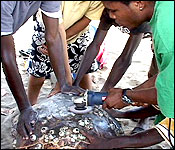
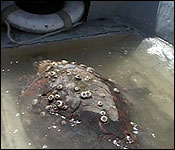
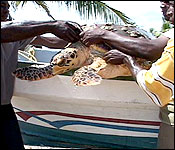
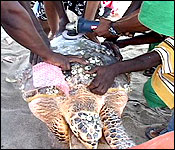 The hawksbill turtle is a protected species in Belize - and - as that status denotes - its numbers in the wild are in decline - and it is endangered throughout the Caribbean.
The hawksbill turtle is a protected species in Belize - and - as that status denotes - its numbers in the wild are in decline - and it is endangered throughout the Caribbean.
But in the Gales Point wildlife Sanctuary, one of the most thriving nesting beaches for the Hawksbill in the region is still going strong.
And nesting also means the opportunity to encounter some of these spectacular sea turtles and find out the secrets of their far-ranging travels.
We went to Gales Point today where they weren't preparing for Tropical Storm Harvey, they were sand-papering off decades-old barnacles.
Here's more:..
Jules Vasquez Reporting
Putting a sanding machine to a turtle's shell? That may seem cruel and unusual, but really, they're not torturing this mature female hawksbill - they're trying to help.
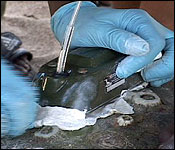
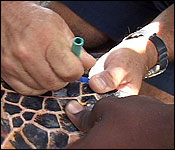
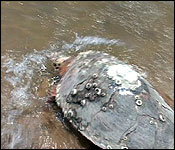 What they're trying to do is sand off these tough barnacles that have molted unto her - and while the old girl looked distressed, maybe even despairing - the grinding continued.
What they're trying to do is sand off these tough barnacles that have molted unto her - and while the old girl looked distressed, maybe even despairing - the grinding continued.
Why? Well, to take it back a few steps, she was captured two nights ago on this beach at the southern edge of the Belize district. As so many turtles do in the area she was laying eggs.
She was detained, not pending charges, but pending the attachment of this satellite tracking device.
So after being stored in this boat's bottom flapping furiously she was carted across the beach to this simple plank where no less than five strapping young man had to hold her down for the grinding off of those barnacles then some finding - which put her no more at ease and then the epoxy application.
And attachment of tracking device - which may not look like much - but is a five thousand dollars piece of hardware that sends out signals all day telling the world where she is..
And for all that money - you know there had to be a sponsorship tie in - this time it's PACT.
She seemed thoroughly un-impressed - but it is for the good of her species:
Kevin Andrewin, Chairperson - Gales Point Wildlife Sanctuary
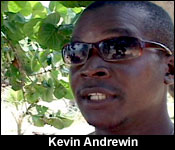 "What we are trying to do is install some satellite tag that we could track their migration pattern and also to tell how much time they come unless on the beach. Well we know normally they do 5-6 clutch but we want to be exact...we don't want to assume and also to see if they are in any danger, if they travel to any other country and check the population. That would give us an idea of how far these turtle migrate and it will also give an idea how it will return back to the nesting beach, whether it takes 3 or 4 or 6 years."
"What we are trying to do is install some satellite tag that we could track their migration pattern and also to tell how much time they come unless on the beach. Well we know normally they do 5-6 clutch but we want to be exact...we don't want to assume and also to see if they are in any danger, if they travel to any other country and check the population. That would give us an idea of how far these turtle migrate and it will also give an idea how it will return back to the nesting beach, whether it takes 3 or 4 or 6 years."
The satellite tag mounted on her back will last between three and ten months - and during that time - all types of information about her movement will be transmitted to researchers.
But before she started to move there was more odious testing to be done - measuring, and that other process no mature female is ever at ease with, weighing - and she made her displeasure known:
Kevin Andrewin, Chairperson - Gales Point Wildlife Sanctuary
"This is one of the biggest turtle we caught so far on the beach. She is a full grown female in good health and condition. She weighs 160-170 pounds - that a full grown female and a full grown female like that definitely will have the age of a little bit over 100 years old."
You heard right - she's more than a hundred years old - and some of them live to 200 years old - so no you know why those barnacles look so hardy - they've been formed in over a century of saltwater immersion! An incredible animal for sure
Linda Searle, Ecomar
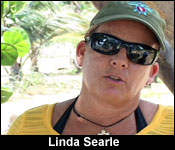 "They've evolve 110 million years ago. They are essentially living dinosaurs and they are very beautiful in the water. There is only 7 species in the world. They are very interesting to study. They migrate long distances. Some of the turtles that we spotted at Robinson Point - they actually nest in Costa Rica and they feed at Robinson Point. So every 3 years they migrate back to Costa Rica to nest which is like 1,500 miles."
"They've evolve 110 million years ago. They are essentially living dinosaurs and they are very beautiful in the water. There is only 7 species in the world. They are very interesting to study. They migrate long distances. Some of the turtles that we spotted at Robinson Point - they actually nest in Costa Rica and they feed at Robinson Point. So every 3 years they migrate back to Costa Rica to nest which is like 1,500 miles."
They are the great ocean migrators and it's rare to get such a robust, well-aged specimen and tissue samples were also taken and she was embedded with a computer chip.
Linda Searle, Ecomar
"And also we take a tissue sample and what we are going to do is send away the tissue sample because actually the DNA from each turtle can be link to its nesting beach. We also put a pit-tag underneath the skin so if somebody was to encounter that turtle again probably in some time they will start to actually tag turtles on this beach and they will be able to record the different locations where the turtle nest."
An incredible animal for sure, and when it was all done, this, heavy old girl was lugged back to the water's edge and from there she knew just what to do - she flapped off like she'd just gotten out of jail, even generating a wake when she sped off.
That is only part one of our story, tune in Monday for part two in which we'll look at one of the very many nesting areas and the pressures facing them on that precious stretch of beach.
So far, two turtles caught on that beach have been fitted with satellite tags and you can follow their tracks through a link at:
http://www.seaturtle.org/tracking/?tag_id=107863
Olive ridley tagge in San Pedro on Aug 8, 2011 in Gulf of Mexico now
http://www.seaturtle.org/tracking/?tag_id=107864
http://www.seaturtle.org/tracking/?tag_id=107865
Hope, Hawksbill from Gales Point currently cruising at Turneffe
For more details on the Belize Turtle Watch Project and Adopt A Beach and Reef please visit: www.ecomarbelize.org
And it's important to underscore that ALL sea turtles are protected by Fisheries Laws and if you see anyone hunting them, report it to the Fisheries Department at 224-4552.



